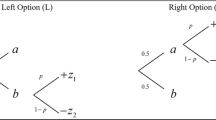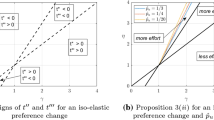Abstract
This paper examines the effect of prudence on the optimal choices of advance and contemporaneous prevention in a context where the two kinds of prevention are used together. We show that, under some conditions on the probability of loss occurrence, prudence tends to increase advance prevention and to reduce contemporaneous prevention, while imprudence tends to do the opposite. Further results on the effect of prudence/imprudence on agents’ optimal behavior are provided.


Similar content being viewed by others
References
Briys, Eric, and Harris Schlesinger. 1990. Risk Aversion and the Propensities for Self-insurance and Self-protection. Southern Economic Journal, 57: 458–467.
Chiu, W. Henry. 2005. Degree of Downside Risk Aversion and Self-protection. Insurance: Mathematics and Economics, 36: 93–101.
Chuang, O-Chia C., Louis Eeckhoudt, Rachel J. Huang, and Larry Y. Tzeng. 2013. Risky Targets and Effort. Insurance: Mathematics and Economics, 52: 465–468
Courbage, Christophe, Henri Loubergé, and Richard Peter. 2015. Optimal Prevention for Multiple Risks. Journal of Risk and Insurance.
Courbage, Christophe, and Béatrice Rey. 2012. Optimal Prevention and Other Risks in a Two-Period Model. Mathematical Social Sciences, 63: 213–217, 2012.
Courbage, Christophe, Béatrice Rey, and Nicolas Treich. 2013. Prevention and Precaution, in Handbook of Insurance, edited by George Dionne. New York: Springer, 185–204.
Crainich, David, Louis Eeckhoudt, and Mario Menegatti. 2016. Changing Risk and Optimal Effort. Journal of Economic Behaviour and Organization, 125: 97–106.
Denuit Michel M., Louis Eeckhoudt, Liqun Liu, and Jack Meyer. 2016. Tradeoffs for Downside Risk-Averse Decision-Makers and the Self-Protection Decision. Geneva Risk and Insurance Review, 41: 19–47.
Dionne, Georges, and Louis Eeckhoudt. 1985. Self-insurance, Self-protection and Increased Risk Aversion. Economics Letters, 17, 39–42.
Eeckhoudt, Louis, and Christian Gollier. 2005. The Impact of Prudence on Optimal Prevention. Economic Theory, 26: 989–994.
Eeckhoudt, Louis, Rachel J. Huang, and Larry Y. Tzeng. 2012. Precautionary Effort: A New Look. Journal of Risk and Insurance, 79: 585–590.
Eeckhoudt, Louis, and Harris Schlesinger. 2006. Putting Risk in Its Proper Place. American Economic Review, 96: 280–289.
Ehrlich, Isaac, and Gary S. Becker. 1972. Market Insurance,Self-insurance, and Self-protection. Journal of Political Economy, 80: 623–648.
Hofmann, Annette, and Richard Peter. 2011. Safe Today or Sorry Tomorrow? The Impact of Time-Structure on Optimal Prevention. Munich Risk and Insurance Center, Working Paper 4.
Hofmann, Annette, and Richard Peter. 2015. Multivariate Prevention Decisions: Safe Today or Sorry Tomorrow? Economics Letters, 128: 51–53.
Hofmann, Annette, and Richard Peter. 2016. Self-Insurance, Self-protection, and Saving: On Consumption Smoothing and Risk Management. Journal of Risk and Insurance, 83: 719–734.
Huang Yi-Chieh, Larry Y. Tzeng, and Lin Zhao. 2015. Comparative Ambiguity Aversion and Downside Ambiguity Aversion. Insurance: Mathematics and Economics, 62: 257–269.
Huang, Rachel J. 2012. Ambiguity Aversion, Higher-Order Risk Attitude and Optimal Effort. Insurance: Mathematics and Economics, 50: 338–345.
Julien Bruno, Salanié Bernard, and Francois Salanié. 1999. Should More Risk-Averse Agents Exert More Effort? Geneva Papers on Risk and Insurance Theory, 24: 19–28.
Menegatti, Mario. 2007. A new interpretation for the precautionary saving motive: a note. Journal of Economics, 92: 275-280.
Menegatti, Mario. 2009. Optimal Prevention and Prudence in a Two-Period Model. Mathematical Social Sciences, 58: 393–397.
Menegatti, Mario. 2012. New Results on Optimal Prevention of Risk Averse Agents. Economics Bulletin, 32: 2166–2173.
Menegatti, Mario. 2014a. Optimal Choice on Prevention and Cure: A New Economic Analysis. European Journal of Health Economics, 15: 363–372.
Menegatti, Mario. 2014b. New Results on the Relationship Among Risk Aversion, Prudence and Temperance. European Journal of Operational Research, 232: 613–617.
Menegatti, Mario, and Filippo Rebessi. 2011. On the substitution between prevention and saving. Mathematical Social Sciences, 62: 176–182.
Nocetti, Diego. 2015. Robust Comparative Statics of Risk Changes. Management Science, 62: 1381–1392.
Read, Daniel, George Loewenstein, and Matthew Rabin. 1999. Choice bracketing. Journal of Risk and Uncertainty, 19: 171–197.
Wang, Jiangli, and Jingyuan Li. 2015. Precautionary Effort: Another Trait for Prudence. Journal of Risk and Insurance, 82: 977–983.
Wang, Hongxia, Jiangli J. Wang, Jingyuan Li, and Xinping Xia. 2015. Precautionary paying for stochastic improvements under background risks. Insurance: Mathematics and Economics, 64: 180–185.
Xue, Minggao, and Wen Cheng. 2013. Background risk, bivariate risk attitudes, and optimal prevention. Mathematical Social Sciences, 66: 390–395.
Acknowledgments
The author would like to thank Louis Eeckhoudt, Richard Peter, two anonymous referees and the Associate Editor Diego Nocetti for their useful comments and suggestions. The usual disclaimers apply.
Author information
Authors and Affiliations
Corresponding author
Rights and permissions
About this article
Cite this article
Menegatti, M. Prudence and Different Kinds of Prevention. Eastern Econ J 44, 273–285 (2018). https://doi.org/10.1057/s41302-016-0081-y
Published:
Issue Date:
DOI: https://doi.org/10.1057/s41302-016-0081-y




